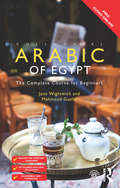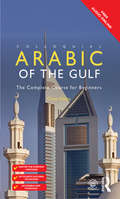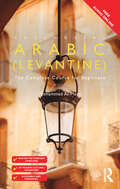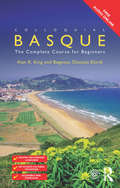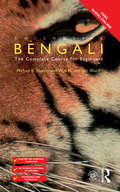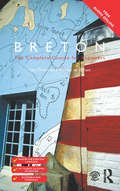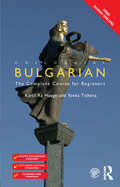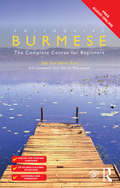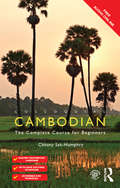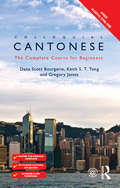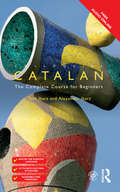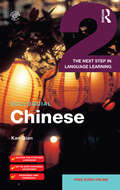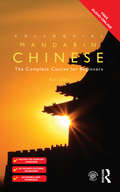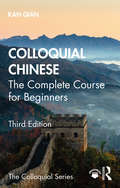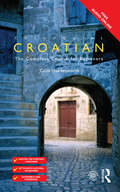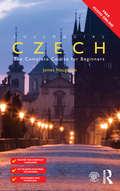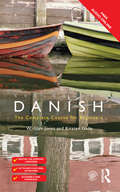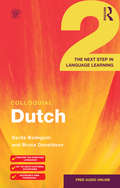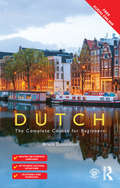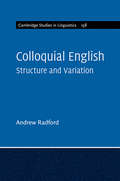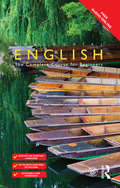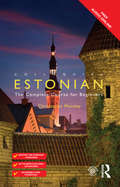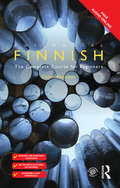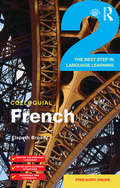- Table View
- List View
Colloquial Arabic of Egypt: The Complete Course for Beginners (Colloquial Ser.)
by Jane Wightwick Mahmoud GaafarColloquial Arabic of Egypt provides a step-by-step course in spoken Egyptian Arabic – the most widely understood dialect in the Arab world. Combining a user-friendly approach with a thorough treatment of the language, it equips learners with the essential skills needed to communicate confidently and effectively in Egyptian Arabic in a broad range of situations. No prior knowledge of the language is required. Key features include: Arabic in romanization form throughout, with optional Arabic script supplements emphasis on modern conversational language with clear pronunciation guidance progressive introduction to the Arabic alphabet to aid familiarity with simple labels and signs grammar section and bilingual glossaries for easy reference stimulating exercises with lively illustrations new e-resources at www.routledge.com/cw/colloquialsoffering supplementary materials for teachers and learners, including extra activities (and answers), vocabulary lists and cultural information, ideas for group activities linked to each unit in the course, listing of the complete Arabic alphabet, notes comparing Egyptian and Standard Arabic and downloadable additional audio tracks. Balanced, comprehensive and rewarding, this new and revised edition of Colloquial Arabic of Egypt offers an indispensable resource both for independent learners and for students taking courses in Egyptian Arabic. By the end of this course, you will be at Level B1 of the Common European Framework for Languages and at the Intermediate-Mid on the ACTFL proficiency scales. Audio material to accompany the course is available to download free in MP3 format from www.routledge.com/cw/colloquials. Recorded by native speakers, the audio material features the dialogues and texts from the book and will help develop your listening and pronunciation skills.
Colloquial Arabic of the Gulf (Colloquial Ser.)
by Clive HolesThis new edition of Colloquial Arabic of the Gulf has been revised and updated to make learning this variety of Arabic easier and more enjoyable than ever before. Specially written by an expert for self-study and classroom use, the course offers you a step-by-step approach to spoken Arabic of the Gulf, together with an introduction to reading signs, business cards, advertisements and other realia. No prior knowledge of the language is required. Each unit presents numerous grammatical points that are reinforced with a wide range of exercises for regular practice. A full answer key can be found at the back as well as useful vocabulary summaries throughout. Features new to this edition include: a ‘Cultural Point’ section in each unit on important aspects of Gulf culture, society and history, with photographs and realia a ‘Reading Arabic’ section in each unit, plus a special appendix on the Arabic script comprehensive glossaries, both English-Arabic and Arabic-English, containing all the words in the book extra notes on the dialects of Oman. By the end of this rewarding course you will be able to communicate confidently and effectively in Arabic in a broad range of situations. Audio material to accompany the course is available to download free in MP3 format from www.routledge.com/cw/colloquials. Recorded by native speakers, the audio material features the dialogues and texts from the book and will help develop your listening and pronunciation skills. .
Colloquial Arabic: The Complete Course for Beginners (Colloquial Series)
by Mohammad Al-MasriColloquial Arabic (Levantine) provides a step-by-step course in Levantine Arabic as it is used today. Combining a user-friendly approach with a thorough treatment of the language, it equips learners with the essential skills needed to communicate confidently and effectively in Levantine Arabic in a broad range of situations. No prior knowledge of the language is required. Key features include: progressive coverage of speaking, listening, reading and writing skills structured, jargon-free explanations of grammar an extensive range of focused and stimulating exercises realistic and entertaining dialogues covering a broad variety of scenarios useful vocabulary lists throughout the text additional resources available at the back of the book, including a full answer key and bilingual glossaries. Balanced, comprehensive and rewarding, Colloquial Arabic (Levantine) is an indispensable resource both for independent learners and students taking courses in Levantine Arabic. Colloquials are now supported by FREE AUDIO available online. All audio tracks referenced within the text are free to stream or download from www.routledge.com/cw/colloquials. Recorded by native speakers, the audio complements the book and will help enhance learners’ listening and speaking skills. By the end of this course, you will be at Level B1 of the Common European Framework for Languages and at the Intermediate-Low on the ACTFL proficiency scales.
Colloquial Basque: A Complete Language Course (Colloquial Ser.)
by Begotxu Olaizola Elordi Alan R. KingColloquial Basque: The Complete Course for Beginners has been carefully developed by an experienced teacher to provide a step-by-step course to Basque as it is written and spoken today. Combining a clear, practical and accessible style with a methodical and thorough treatment of the language, it equips learners with the essential skills needed to communicate confidently and effectively in Basque in a broad range of situations. No prior knowledge of the language is required. Colloquial Basque is exceptional; each unit presents a wealth of grammatical points that are reinforced with a wide range of exercises for regular practice. A full answer key, a grammar summary, bilingual glossaries and English translations of dialogues can be found at the back as well as useful vocabulary lists throughout. Key features include: A clear, user-friendly format designed to help learners progressively build up their speaking, listening, reading and writing skills Jargon-free, succinct and clearly structured explanations of grammar An extensive range of focused and dynamic supportive exercises Realistic and entertaining dialogues covering a broad variety of narrative situations Helpful cultural points explaining the customs and features of life in n the Basque countryAn overview of the sounds of Basque Balanced, comprehensive and rewarding, Colloquial Basque is an indispensable resource both for independent learners and students taking courses in Basque. Audio material to accompany the course is available to download free in MP3 format from www.routledge.com/cw/colloquials. Recorded by native speakers, the audio material features the dialogues and texts from the book and will help develop your listening and pronunciation skills.
Colloquial Bengali (Colloquial Ser.)
by Mithun B. Nasrin W.A.M Van Der WurffColloquial Bengali provides a step-by-step course in Bengali as it is written and spoken today. Combining a user-friendly approach with a thorough treatment of the language, it equips learners with the essential skills needed to communicate confidently and effectively in Bengali in a broad range of situations. No prior knowledge of the language is required. Key features include: • progressive coverage of speaking, listening, reading and writing skills • structured, jargon-free explanations of grammar • an extensive range of focused and stimulating exercises • realistic and entertaining dialogues covering a broad variety of scenarios • useful vocabulary lists throughout the text • additional resources available at the back of the book, including a full answer key, a grammar summary and bilingual glossaries Balanced, comprehensive and rewarding, Colloquial Bengali will be an indispensable resource both for independent learners and students taking courses in Bengali. Audio material to accompany the course is available to download freely in MP3 format from www.routledge.com/cw/colloquials. Recorded by native speakers, the audio material features the dialogues and texts from the book and will help develop your listening and pronunciation skills.
Colloquial Breton: The Complete Course For Beginners (Colloquial Ser. #5)
by Herve Ar Bihan Ian PressColloquial Breton: The Complete Course for Beginners has been carefully developed by an experienced teacher to provide a step-by-step course to Breton as it is written and spoken today. Combining a clear, practical and accessible style with a methodical and thorough treatment of the language, it equips learners with the essential skills needed to communicate confidently and effectively in Breton in a broad range of situations. No prior knowledge of the language is required. Colloquial Breton is exceptional; each unit presents a wealth of grammatical points that are reinforced with a wide range of exercises for regular practice. A full answer key, a grammar summary, bilingual glossaries and English translations of dialogues can be found at the back as well as useful vocabulary lists throughout. Key features include: A clear, user-friendly format designed to help learners progressively build up their speaking, listening, reading and writing skills Jargon-free, succinct and clearly structured explanations of grammar An extensive range of focused and dynamic supportive exercises Realistic and entertaining dialogues covering a broad variety of narrative situations Helpful cultural points An overview of the sounds of Breton Balanced, comprehensive and rewarding, Colloquial Breton is an indispensable resource both for independent learners and students taking courses in Breton. Audio material to accompany the course is available to download free in MP3 format from www.routledge.com/cw/colloquials. Recorded by native speakers, the audio material features the dialogues and texts from the book and will help develop your listening and pronunciation skills.
Colloquial Bulgarian: The Complete Course For Beginners (Colloquial Ser.)
by Kjetil Ra Hauge Yovka TishevaColloquial Bulgarian: The Complete Course for Beginners has been carefully developed by an experienced teacher to provide a step-by-step course to Bulgarian as it is written and spoken today. Combining a clear, practical and accessible style with a methodical and thorough treatment of the language, it equips learners with the essential skills needed to communicate confidently and effectively in Bulgarian in a broad range of situations. No prior knowledge of the language is required. Colloquial Bulgarian is exceptional; each unit presents a wealth of grammatical points that are reinforced with a wide range of exercises for regular practice. A full answer key, a grammar summary, bilingual glossaries and English translations of dialogues can be found at the back as well as useful vocabulary lists throughout. Key features include: A clear, user-friendly format designed to help learners progressively build up their speaking, listening, reading and writing skills Jargon-free, succinct and clearly structured explanations of grammar An extensive range of focused and dynamic supportive exercises Realistic and entertaining dialogues covering a broad variety of narrative situations Helpful cultural points explaining the customs and features of life in Bulgaria An overview of the sounds and alphabet of Bulgarian Balanced, comprehensive and rewarding, Colloquial Bulgarian is an indispensable resource both for independent learners and students taking courses in Bulgarian. Audio material to accompany the course is available to download freely in MP3 format from www.routledge.com/cw/colloquials. Recorded by native speakers, the audio material features the dialogues and texts from the book and will help develop your listening and pronunciation skills.
Colloquial Burmese: The Complete Course for Beginners (The\colloquial Ser.)
by San San Hnin Tun Patrick McCormickColloquial Burmese provides a step-by-step course in Burmese as it is written and spoken today. Combining a user-friendly approach with a thorough treatment of the language, it equips learners with the essential skills needed to communicate confidently and effectively in Burmese in a broad range of situations. No prior knowledge of the language is required. Key features include: progressive coverage of speaking, listening, reading and writing skills structured, jargon-free explanations of grammar an extensive range of focused and stimulating exercises realistic and entertaining dialogues covering a broad variety of scenarios useful vocabulary lists throughout the text review chapters at intervals throughout the text providing motivational checklists of language points covered an overview of the sounds of Burmese A full answer key and glossary at the back of the book Balanced, comprehensive and rewarding, Colloquial Burmese will be an indispensable resource both for independent learners and for students taking courses in Burmese. Audio material to accompany the course is available to download free in MP3 format from www.routledge.com/cw/colloquials. Recorded by native speakers, the audio material features the dialogues and texts from the book and will help develop your listening and pronunciation skills.
Colloquial Cambodian: The Complete Course for Beginners (New Edition) (Colloquial Series)
by Chhany Sak-HumphryColloquial Cambodian provides a step-by-step course in Cambodian as it is written and spoken today. Colloquial Cambodian has been developed by a linguist and an experienced Cambodian language professor and combines an accessible approach with a thorough treatment of the language, equipping learners with the essential skills needed to communicate confidently and effectively in Cambodian in a broad range of situations. No prior knowledge of the language is required. Key features include: progressive coverage of speaking, listening, reading, and writing skills jargon-free explanations of grammar an extensive range of focused and stimulating exercises realistic and entertaining dialogues covering a broad variety of scenarios coverage of the Cambodian writing script useful vocabulary lists throughout the text additional resources available at the back of the book, including a full answer key, a grammar summary, bilingual glossaries, and translations of dialogues and reading passages. Balanced, comprehensive, and rewarding, Colloquial Cambodian is an indispensable resource both for independent learners and for students taking courses in Cambodian. Accompanying audio material is available for free download from www.routledge.com/9780415524070 in MP3 format. Recorded by native speakers, the audio complements the book and will help enhance learners’ listening and speaking skills.
Colloquial Cantonese: The Complete Course for Beginners (Colloquial Series)
by Gregory James Dana Scott Bourgerie Keith S TongColloquial Cantonese: The Complete Course for Beginners has been carefully developed by an experienced teacher to provide a step-by-step course to Cantonese as it is written and spoken today. Combining a clear, practical and accessible style with a methodical and thorough treatment of the language, it equips learners with the essential skills needed to communicate confidently and effectively in Cantonese in a broad range of situations. No prior knowledge of the language is required. Colloquial Cantonese is exceptional; each unit presents a wealth of grammatical points that are reinforced with a wide range of exercises for regular practice. A full answer key, a grammar summary, bilingual glossaries and English translations of dialogues can be found at the back as well as useful vocabulary lists throughout. Key features include: A clear, user-friendly format designed to help learners progressively build up their speaking, listening, reading and writing skills Jargon-free, succinct and clearly structured explanations of grammar An extensive range of focused and dynamic supportive exercises Realistic and entertaining dialogues covering a broad variety of narrative situations Helpful cultural points explaining the customs and features of life in Hong Kong An overview of the sounds of Cantonese Balanced, comprehensive and rewarding, Colloquial Cantonese is an indispensable resource both for independent learners and students taking courses in Cantonese. Audio material to accompany the course is available to download free in MP3 format from www.routledge.com/cw/colloquials. Recorded by native speakers, the audio material features the dialogues and texts from the book and will help develop your listening and pronunciation skills. .
Colloquial Catalan: A Complete Course for Beginners (Colloquial Ser.)
by Alexander Ibarz Toni IbarzColloquial Catalan provides a step-by-step course in Catalan as it is written and spoken today. Combining a user-friendly approach with a thorough treatment of the language, it equips learners with the essential skills needed to communicate confidently and effectively in Catalan in a broad range of situations. No prior knowledge of the language is required. Key features include: • progressive coverage of speaking, listening, reading and writing skills • structured, jargon-free explanations of grammar • an extensive range of focused and stimulating exercises • realistic and entertaining dialogues covering a broad variety of scenarios • useful vocabulary lists throughout the text • additional resources available at the back of the book, including a full answer key, a grammar summary and bilingual glossaries Balanced, comprehensive and rewarding, Colloquial Catalan will be an indispensable resource both for independent learners and students taking courses in Catalan. Audio material to accompany the course is available to download free in MP3 format from www.routledge.com/cw/colloquials. Recorded by native speakers, the audio material features the dialogues and texts from the book and will help develop your listening and pronunciation skills.
Colloquial Chinese 2: The Next Step in Language Learning (Colloquial Series)
by Kan QianColloquial Chinese 2 is designed for those who already have some knowledge of Chinese. It is ideal for refreshing and extending your grasp of Chinese grammar and vocabulary, either in preparation for travel or work. Key features include revision material to help the consolidation of basics a range of Chinese reading texts presented in simplified characters and pinyin romanization lessons based on practical everyday topics and supplemented by useful cultural notes lots of spoken and written exercises in each lesson for practice and consolidation a grammar summary detailed answer key Chinese-English glossary Audio material to accompany the course is available to download free in MP3 format from www.routledge.com/cw/colloquials. Recorded by native speakers, the audio material features the dialogues and texts from the book and will help develop your listening and pronunciation skills.
Colloquial Chinese 2: The Next Step in Language Learning (Colloquial Series)
by Kan QianColloquial Chinese 2 is designed for those who already have some knowledge of Chinese. It is ideal for refreshing and extending your grasp of Chinese grammar and vocabulary, either in preparation for travel or work. Key features include revision material to help the consolidation of basics a range of Chinese reading texts presented in simplified characters and pinyin romanization lessons based on practical everyday topics and supplemented by useful cultural notes lots of spoken and written exercises in each lesson for practice and consolidation a grammar summary detailed answer key Chinese-English glossary Audio material to accompany the course is available to download free in MP3 format from www.routledge.com/cw/colloquials. Recorded by native speakers, the audio material features the dialogues and texts from the book and will help develop your listening and pronunciation skills.
Colloquial Chinese: The Complete Course for Beginners
by Qian KanColloquial Chinese: The Complete Course for Beginners has been carefully developed by an experienced teacher to provide a step-by-step course to Chinese as it is written and spoken today. Combining a clear, practical and accessible style with a methodical and thorough treatment of the language, it equips learners with the essential skills needed to communicate confidently and effectively in Chinese in a broad range of situations. No prior knowledge of the language is required. Colloquial Chinese is exceptional; each unit presents a wealth of grammatical points that are reinforced with a wide range of exercises for regular practice. A full answer key, a grammar summary, bilingual glossaries and English translations of dialogues can be found at the back as well as useful vocabulary lists throughout. Key features include: A clear, user-friendly format designed to help learners progressively build up their speaking, listening, reading and writing skills Jargon-free, succinct and clearly structured explanations of grammar An extensive range of focused and dynamic supportive exercises Realistic and entertaining dialogues covering a broad variety of narrative situations Helpful cultural points explaining the customs and features of life in China An overview of the sounds of Chinese Balanced, comprehensive and rewarding, Colloquial Chinese is an indispensable resource both for independent learners and students taking courses in Chinese. Audio material to accompany the course is available to download free in MP3 format from www.routledge.com/cw/colloquials. Recorded by native speakers, the audio material features the dialogues and texts from the book and will help develop your listening and pronunciation skills.
Colloquial Chinese: The Complete Course for Beginners
by Qian KanColloquial Chinese: The Complete Course for Beginners has been carefully developed by a leading academic in Chinese language teaching and course design. Based on feedback from learners and teachers who used its previous version, this new edition has been updated to reflect the language and cultural changes in China, such as online shopping and WeChat payment, and to provide a more integrated and step-by-step approach to making the learning of modern Mandarin Chinese more effective and enjoyable. Combining a clear, practical and accessible style with a methodical and thorough treatment of the language, it equips learners with the essential knowledge and skills needed to communicate confidently and effectively in Chinese in a broad range of situations. No prior knowledge of the language is required. Colloquial Chinese is exceptional; each unit presents a wealth of grammatical points that are reinforced with a wide range of exercises for regular practice. A full answer key, a grammar summary, bilingual glossaries and English translations of dialogues can be found at the back, as well as transcripts of listening practice exercises. Key features include: A clear, user-friendly format designed to help learners progressively build up their speaking, listening, reading and writing skills Jargon-free, succinct and clearly structured explanations of grammar Step by step introduction of Chinese characters An extensive range of focused and dynamic supportive exercises A combination of listening, reading and speaking activities with the support of transcripts at the back of the book Realistic and entertaining dialogues covering a broad variety of narrative situations Helpful cultural points explaining the customs and features of life in China An overview of the Chinese language: its sounds, structure and Chinese characters Balanced, comprehensive and rewarding, Colloquial Chinese is an indispensable resource both for independent learners and students taking courses in Chinese as well as teachers of Chinese. Audio material to accompany the course is available to download free in MP3 format from www.routledge.com/cw/colloquials. Recorded by native speakers, the audio material features the dialogues, new words and listening practice exercises from the book and will help develop your listening and speaking skills.
Colloquial Croatian: The Complete Course For Beginners (Colloquial Ser.)
by Celia HawkesworthColloquial Croatian provides a step-by-step course in Croatian as it is written and spoken today. Combining a user-friendly approach with a thorough treatment of the language, it equips learners with the essential skills needed to communicate confidently and effectively in Croatian in a broad range of situations. No prior knowledge of the language is required. Key features include: • progressive coverage of speaking, listening, reading and writing skills • structured, jargon-free explanations of grammar • an extensive range of focused and stimulating exercises • realistic and entertaining dialogues covering a broad variety of scenarios • useful vocabulary lists throughout the text • additional resources available at the back of the book, including a full answer key, a grammar summary and bilingual glossaries Balanced, comprehensive and rewarding, Colloquial Croatian will be an indispensable resource both for independent learners and students taking courses in Croatian. Audio material to accompany the course is available to download free in MP3 format from www.routledge.com/cw/colloquials. Recorded by native speakers, the audio material features the dialogues and texts from the book and will help develop your listening and pronunciation skills.
Colloquial Czech: The Complete Course for Beginners (Colloquials Ser.)
by James NaughtonColloquial Czech provides a step-by-step course in Czech as it is written and spoken today. Combining a user-friendly approach with a thorough treatment of the language, it equips learners with the essential skills needed to communicate confidently and effectively in Czech in a broad range of situations. No prior knowledge of the language is required. Key features include: • progressive coverage of speaking, listening, reading and writing skills • structured, jargon-free explanations of grammar • an extensive range of focused and stimulating exercises • realistic and entertaining dialogues covering a broad variety of scenarios • useful vocabulary lists throughout the text • additional resources available at the back of the book, including a full answer key, a grammar summary and bilingual glossaries Balanced, comprehensive and rewarding, Colloquial Czech will be an indispensable resource both for independent learners and students taking courses in Czech. Audio material to accompany the course is available to download free in MP3 format from www.routledge.com/cw/colloquials. Recorded by native speakers, the audio material features the dialogues and texts from the book and will help develop your listening and pronunciation skills.
Colloquial Danish: The Complete Course For Beginners (Colloquial Ser.)
by Kirsten Gade W. Glyn JonesColloquial Danish provides a step-by-step course in Danish as it is written and spoken today. Combining a user-friendly approach with a thorough treatment of the language, it equips learners with the essential skills needed to communicate confidently and effectively in Danish in a broad range of situations. No prior knowledge of the language is required. Key features include: • progressive coverage of speaking, listening, reading and writing skills • structured, jargon-free explanations of grammar • an extensive range of focused and stimulating exercises • realistic and entertaining dialogues covering a broad variety of scenarios • useful vocabulary lists throughout the text • additional resources available at the back of the book, including a full answer key, a grammar summary and bilingual glossaries Balanced, comprehensive and rewarding, Colloquial Danish will be an indispensable resource both for independent learners and students taking courses in Danish. Audio material to accompany the course is available to download free in MP3 format from www.routledge.com/cw/colloquials. Recorded by native speakers, the audio material features the dialogues and texts from the book and will help develop your listening and pronunciation skills.
Colloquial Dutch 2: The Next Step in Language Learning (Colloquial Ser.)
by Bruce Donaldson Gerda BodegomColloquial Dutch 2 is the next step in language learning for those who already have a basic knowledge of Dutch. The authentic dialogues, texts and variety of exercises in this course will help learners to consolidate their language skills and further their language competence. Key features include: a section devoted to idiomatic expressions in each unit cultural points and information on various dialects vocabulary lists relative to the topics of each unit. Audio material to accompany the course is available to download free in MP3 format from www.routledge.com/cw/colloquials. Recorded by native speakers, the audio material features the dialogues and texts from the book and will help develop your listening and pronunciation skills.
Colloquial Dutch: A Complete Language Course (Colloquial Ser. #10)
by Bruce DonaldsonColloquial Dutch provides a step-by-step course in Dutch as it is written and spoken today. Combining a user-friendly approach with a thorough treatment of the language, it equips learners with the essential skills needed to communicate confidently and effectively in Dutch in a broad range of situations. No prior knowledge of the language is required. Key features include: A clear, user-friendly format designed to help learners progressively build up their speaking, listening, reading and writing skills Jargon-free, succinct and clearly structured explanations of grammar An extensive range of focused and dynamic supportive exercises Realistic and entertaining dialogues covering a broad variety of narrative situations Helpful cultural points explaining the customs and features of life in The Netherlands An overview of the sounds of Dutch. Balanced, comprehensive and rewarding, Colloquial Dutch is an indispensable resource both for independent learners and students taking courses in Dutch. Colloquials are now supported by FREE AUDIO available online. All audio tracks referenced within the text are free to stream or download from www.routledge.com/cw/colloquials. Recorded by native speakers, the audio complements the book and will help enhance learners’ listening and speaking skills.
Colloquial English: Structure and Variation (Cambridge Studies in Linguistics #158)
by Andrew RadfordDrawing on vast amounts of new data from live, unscripted radio and TV broadcasts, and the internet, this is a brilliant and original analysis of colloquial English, revealing unusual and largely unreported types of clause structure. Andrew Radford debunks the myth that colloquial English has a substandard, simplified grammar, and shows that it has a coherent and complex structure of its own. The book develops a theoretically sophisticated account of structure and variation in colloquial English, advancing an area that has been previously investigated from other perspectives, such as corpus linguistics or conversational analysis, but never before in such detail from a formal syntactic viewpoint.
Colloquial English: The Complete Course for Beginners (Colloquial Ser.)
by Gareth KingColloquial English provides a step-by-step course in English as it is written and spoken today. Combining a user-friendly approach with a thorough treatment of the language, it equips learners with the essential skills needed to communicate confidently and effectively in English in a broad range of situations. Key features include: progressive coverage of speaking, listening, reading and writing skills structured, jargon-free explanations of grammar an extensive range of focused and stimulating exercises realistic and entertaining dialogues covering a broad variety of scenarios useful explanations of idioms throughout the text additional resources available at the back of the book, including a full answer key and lists of irregular verbs. This second edition has been extensively revised and updated throughout, and includes up-to-date cultural information, an improved reference grammar and revised audio recordings. Audio material to accompany the course is available to download free in MP3 format from www.routledge.com/cw/colloquials. Recorded by native speakers, the audio material features the dialogues and texts from the book and will help develop your listening and pronunciation skills. Balanced, comprehensive and rewarding, Colloquial English is a complete English Language course and will be an indispensable resource for independent learners and for instructors and students on TEFL and EFL courses. By the end of this course, you will be at Level B2 of the Common European Framework for Languages and at the Intermediate-High on the ACTFL proficiency scales.
Colloquial Estonian: The Complete Course For Beginners
by Christopher MoseleyThis new edition of Colloquial Estonian is easy to use and completely up-to-date. Specially written by an experienced teacher for self-study or class use, the course offers you a step-by-step approach to written and spoken Estonian. No prior knowledge of the language is required.What makes Colloquial Estonian your best choice in personal language learning? interactive – lots of dialogues and exercises for regular practice clear – concise grammar notes practical – useful vocabulary and pronunciation guide complete – including answer key and special reference section. By the end of this rewarding course you will be able to communicate confidently and effectively in Estonian in a broad range of everyday situations. Audio material to accompany the course is available to download freely in MP3 format from www.routledge.com/cw/colloquials. Recorded by native speakers, the audio material features the dialogues and texts from the book and will help develop your listening and pronunciation skills.
Colloquial Finnish: The Complete Course for Beginners (Colloquial Ser.)
by Daniel AbondoloColloquial Finnish provides a step-by-step course in Finnish as it is written and spoken today. Combining a user-friendly approach with a thorough treatment of the language, it equips learners with the essential skills needed to communicate confidently and effectively in Finnish in a broad range of situations. No prior knowledge of the language is required. Key features include: progressive coverage of speaking, listening, reading and writing skills structured, jargon-free explanations of grammar an extensive range of focused and stimulating exercises realistic and entertaining dialogues covering a broad variety of scenarios useful vocabulary lists throughout the text additional resources available at the back of the book, including a full answer key, a grammar summary and bilingual glossaries Balanced, comprehensive and rewarding, Colloquial Finnish will be an indispensable resource both for independent learners and students taking courses in Finnish. Audio material to accompany the course is available to download freely in MP3 format from www.routledge.com/cw/colloquials. Recorded by native speakers, the audio material features the dialogues and texts from the book and will help develop your listening and pronunciation skills.
Colloquial French 2: The Next step in Language Learning (Colloquial Ser.)
by Elspeth BroadyDo you know French already and want to go a stage further? If you're planning a visit to France, need to brush up your French for work, or are simply doing a course, Colloquial French 2 is the ideal way to refresh your knowledge of the language and to extend your skills. Colloquial French 2 is designed to help those involved in self-study, and structured to give you the opportunity to listen to and read lots of modern, everyday French. It has been developed to work systematically on reinforcing and extending your grasp of French grammar and vocabulary. Key features of Colloquial French 2 include:* a broad range of everyday situations, focusing on France and the wider francophone world* revision: material to help consolidate and build up your basics* a wide range of contemporary documents* spoken and written exercises in each unit* highlighted key structures and phrases, a grammar reference and detailed answer keys Audio material to accompany the course is available to download free in MP3 format from www.routledge.com/cw/colloquials. Recorded by native speakers, the audio material features the dialogues and texts from the book and will help develop your listening and pronunciation skills. Supplementary exercises and French language web-links can also be accessed through this site.
